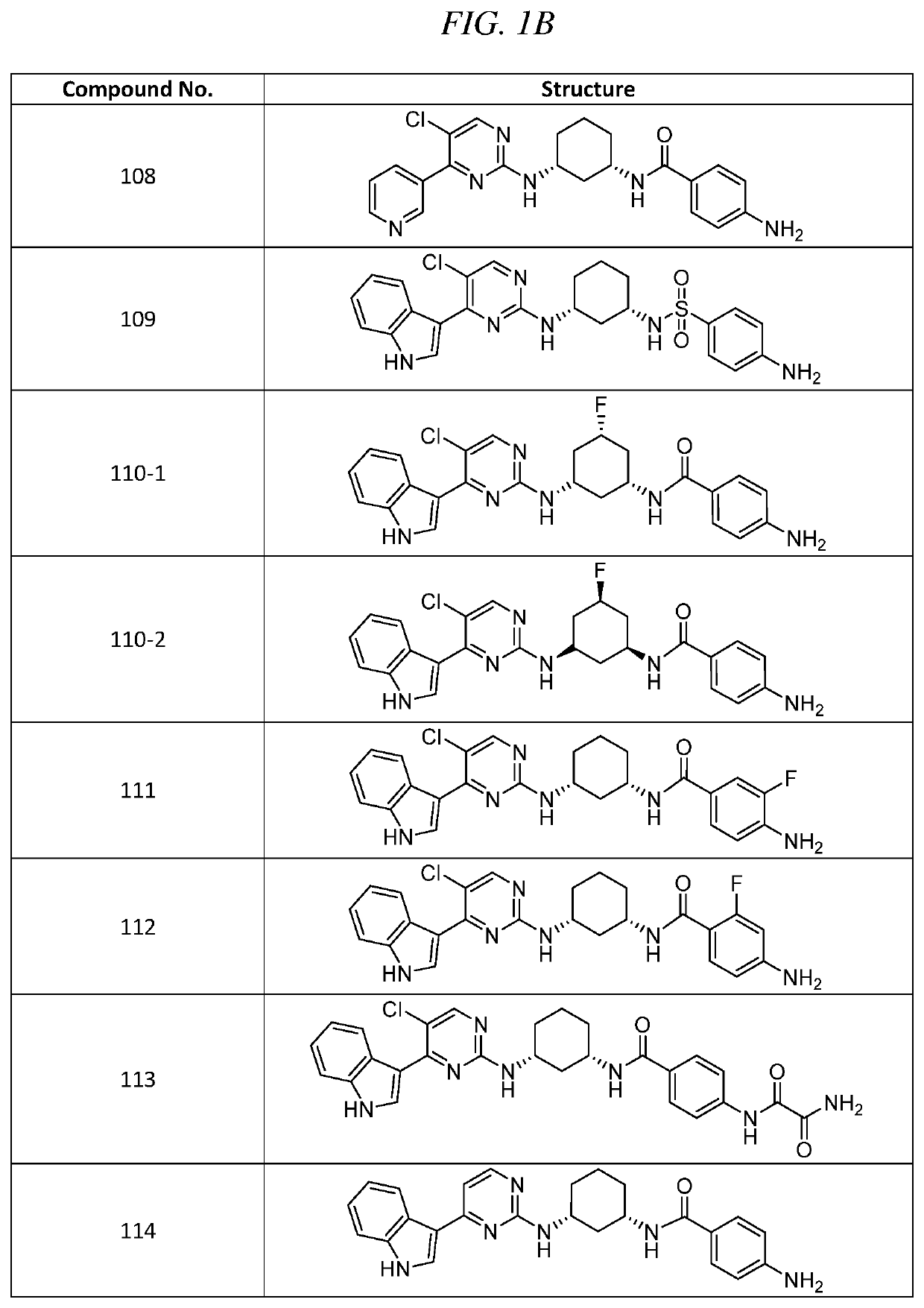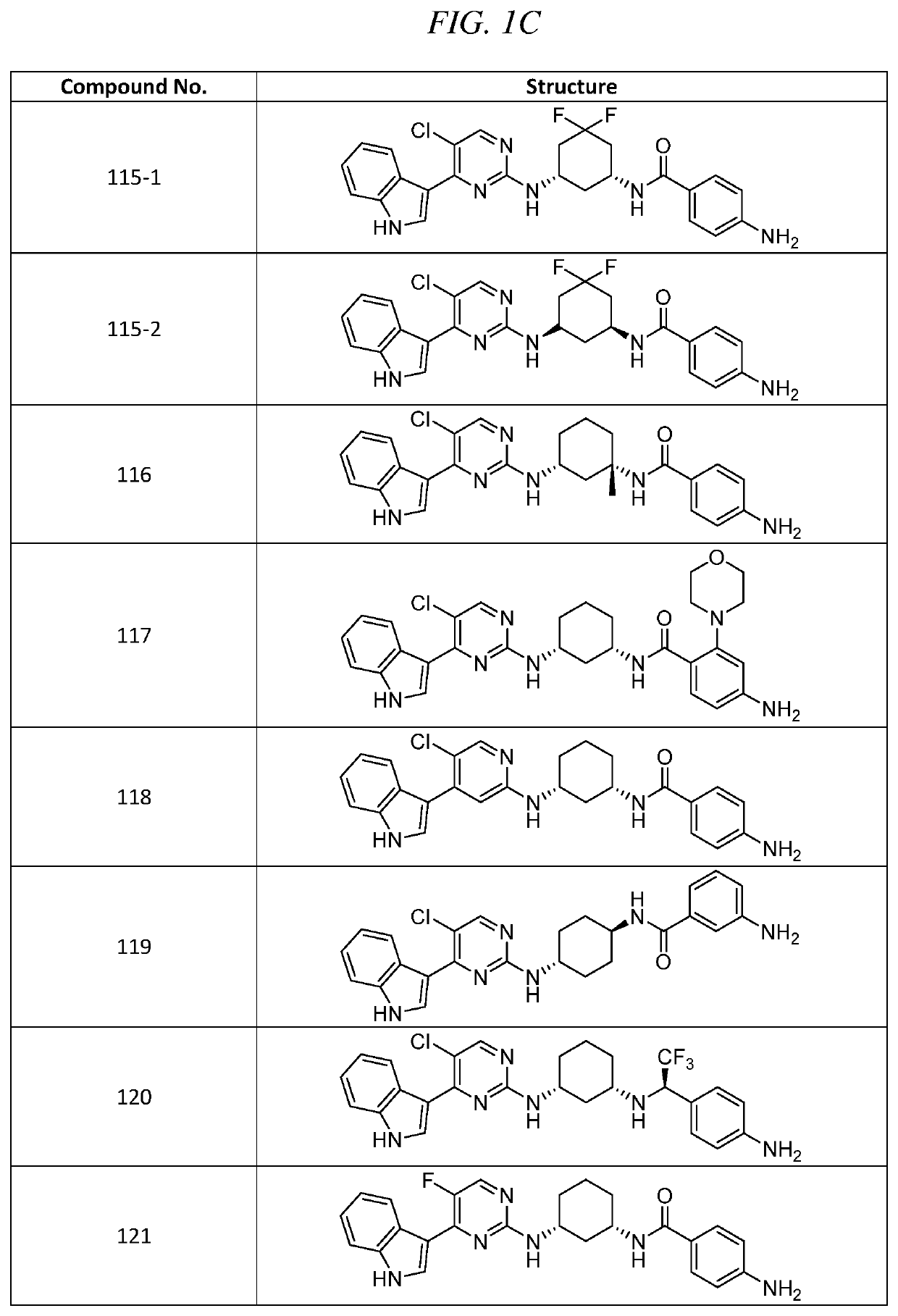Inhibitors of cyclin-dependent kinase 7 (CDK7)
a cyclin-dependent kinase and inhibitor technology, applied in the field of inhibitors of cyclin-dependent kinase 7 (cdk7), can solve the problems of preventing proliferation and hampered discovery of selective inhibitors of cdk7, and achieve the effect of reducing tumor burden and stopping tumor growth or spread
- Summary
- Abstract
- Description
- Claims
- Application Information
AI Technical Summary
Benefits of technology
Problems solved by technology
Method used
Image
Examples
example 2
mino-N-(3-(5-chloro-4-(1H-indol-3-yl)pyrimidin-2-ylamino)-5-hydroxycyclohexyl)benzamide (Compound 101)
(+ / −)-5-(tert-butyldimethylsilyloxy)cyclohexane-1,3-diamine
[0178]
[0179]A degassed solution of tert-butyl((+ / −)-3,5-diazidocyclohexyloxy)dimethylsilane (300 mg, 1.01 mmol) (prepared following New J. Chem., 2005, 29, 1152-1158) in MeOH (7 mL) was treated with 10% Pd / C (108 mg, 0.10 mmol) and stirred 2h under hydrogen (1 atm). The resulting mixture was filtered over a pad of celite and the filtrate was evaporated to dryness leaving the title compound (227 mg, 0.930 mmol, 92%) as a beige solid which was used in the next step without further purification.
(+ / −)-5-(tert-butyldimethylsilyloxy)-N1-(5-chloro-4-(1-(phenylsulfonyl)-1H-indol-3-yl)pyrimidin-2-yl)cyclohexane-1,3-diamine
[0180]
[0181]A solution of 3-(2,5-dichloropyrimidin-4-yl)-1-(phenylsulfonyl)-1H-indole (340 mg, 0.84 mmol), (+ / −)-5-(tert-butyldimethylsilyloxy)cyclohexane-1,3-diamine (226 mg, 0.93 mmol) and DIPEA (161 μL, 0.93 mmol...
example 3.4
Example 3. 4-amino-N-((1S,3R)-3-(5-chloro-4-(1H-indol-3-yl)pyrimidin-2-ylamino)cyclohexyl)benzamide (Compound 102)
(1S,3R)-3-(Benzyloxycarbonylamino)cyclohexylamino 2,2-dimethylpropionate
[0186]
[0187]To a solution of (1R,3S)-3-(tert-butoxycarbonylamino)cyclohexanecarboxylic acid (prepared following Tetrahedron: Asymmetry 2010 (21), 864-866) (8.77 g, 36.1 mmol) was added Et3N (5.53 mL, 39.7 mmol) and DPPA (7.7 mL, 36.1 mmol). The resulting solution was stirred 2h at 110° C. then cooled down to 80° C. Benzyl alcohol (4.66 mL, 45.1 mmol) and triethylamine (5.53 mL, 39.7 mmol) were added and the mixture was stirred 20h at 80° C. The cooled solution was diluted with EtOAc (100 mL) and H2O (50 mL). The layers were separated and the aqueous layer was extracted with EtOAc (2×50 mL). The combined organics were dried (MgSO4), filtered and evaporated to dryness. The residue was purified by SiO2 chromatography (Hex / EtOAc 1 to 100% gradient), and afforded the title compound (9.89 g, 28.4 mmol, 79%...
example 4
-(4-aminophenyl)-3-(5-chloro-4-(1H-indol-3-yl)pyrimidin-2-ylamino)cyclohexanecarboxamide (Compound 106)
(1S,3R)-methyl 3-(tert-butoxycarbonylamino)cyclohexanecarboxylate
[0200]
[0201]A solution of (1R,3S)-3-(tert-butoxycarbonylamino)cyclohexanecarboxylic acid (prepared following Tetrahedron: Asymmetry 2010 (21), 864-866) (1.0 g, 4.11 mmol), K2CO3 (474 mg, 3.43 mmol) and MeI (0.21 mL, 3.43 mmol) in DMF (8 mL) was stirred 72h at rt. The resulting mixture was diluted with H2O (30 mL) and EtOAc (100 mL). The layers were separated and the aqueous layer was extracted with EtOAc (3×50 mL). The combined organic layers were dried over MgSO4, filtered, and evaporated to dryness leaving the title compound (1.35 g, 4.11 mmol, 100%) as a light orange solid which was used in the next step without further purification.
(1S,3R)-methyl 3-aminocyclohexanecarboxylate.HCl
[0202]
[0203]A solution of (1S,3R)-methyl 3-(tert-butoxycarbonylamino)cyclohexanecarboxylate (1.058 g, 4.111 mmol) in DCM (20.6 mL) was tr...
PUM
 Login to View More
Login to View More Abstract
Description
Claims
Application Information
 Login to View More
Login to View More - R&D
- Intellectual Property
- Life Sciences
- Materials
- Tech Scout
- Unparalleled Data Quality
- Higher Quality Content
- 60% Fewer Hallucinations
Browse by: Latest US Patents, China's latest patents, Technical Efficacy Thesaurus, Application Domain, Technology Topic, Popular Technical Reports.
© 2025 PatSnap. All rights reserved.Legal|Privacy policy|Modern Slavery Act Transparency Statement|Sitemap|About US| Contact US: help@patsnap.com



